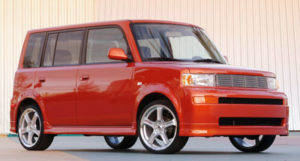 I traded in my 12-year-old Scion xB for a new car. That boxy look was all the rage back when Hummers and Elements, and other functional-looking cargo vehicles were in vogue. The Scion was a fun car to drive despite its meager 100 horsepower, got good mileage around town (30+), had great visibility for the driver, with a nice high vantage point, and it really did pack a lot of cargo space into a small volume. And it was cheap – cheap to buy ($14K in decade-old dollars) and cheap to run (regular gas, Toyota engine that lasted forever with almost no maintenance). It was so cheap that I could afford to put 18” alloy wheels with low-profile tires on it, and it looked very fine, indeed, a strutter.
I traded in my 12-year-old Scion xB for a new car. That boxy look was all the rage back when Hummers and Elements, and other functional-looking cargo vehicles were in vogue. The Scion was a fun car to drive despite its meager 100 horsepower, got good mileage around town (30+), had great visibility for the driver, with a nice high vantage point, and it really did pack a lot of cargo space into a small volume. And it was cheap – cheap to buy ($14K in decade-old dollars) and cheap to run (regular gas, Toyota engine that lasted forever with almost no maintenance). It was so cheap that I could afford to put 18” alloy wheels with low-profile tires on it, and it looked very fine, indeed, a strutter.
But it had downsides. One was virtually no suspension. At less than 2000 pounds, everything about the vehicle was lightweight, including the suspension, so it wasn’t long before each wrinkle in the road was apparent to the driver. The low-profile tires didn’t help that problem. I replaced the rear shocks but that brought only moderate relief. Noise was also in-your-face. It was a thin-walled, “tinny” car, designed for utility, not comfort. Another issue was safety. Back in the ‘00s, cars didn’t surround you with airbags like they do today and the Scion had only one driver, one passenger airbag. Being the very lightweight car that it was, I never did feel it would withstand any sort of a crash. Fortunately, I never tested that, but I do know that safety has come a long way in cars since then.
 The decision to sell came after rats got into it and ate the carpets and the wiring. Disgusting. These are small pack-rats that live in the desert, not big, black river rats that the word “rat” probably conjures to mind for most people. Pack-rats are actually kind of cute, but they’re still rats and not welcome.
The decision to sell came after rats got into it and ate the carpets and the wiring. Disgusting. These are small pack-rats that live in the desert, not big, black river rats that the word “rat” probably conjures to mind for most people. Pack-rats are actually kind of cute, but they’re still rats and not welcome.
I’d had to park the Scion out in the driveway for a few weeks and the little critters found it quickly when I was out of town. They crawl up from underneath and they bring their “treasures” into the engine compartment, treasures like cactus buds and bottle caps. They can eat and nest in cactus buds. Lord only knows what they do with bottle caps. They also eat the vinyl coating on the engine wiring, and nibble away at the floor mats, which I guess are cotton/poly. That’s good nesting material, apparently. And of course they stink. It was a disaster.
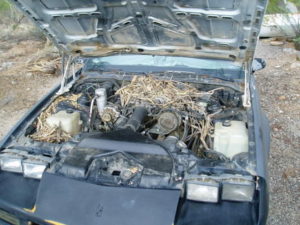 I cleaned out the nest and all the treasures distributed under the seats and throughout the cabin, no easy task. I never saw the little homeowners themselves, thank goodness. They’re nocturnal, I believe. I got the wiring repaired. The shop said rat damage was very common and that I had gotten off lightly. Fortunately I’d caught them before they’d done serious harm and engine still worked fine.
I cleaned out the nest and all the treasures distributed under the seats and throughout the cabin, no easy task. I never saw the little homeowners themselves, thank goodness. They’re nocturnal, I believe. I got the wiring repaired. The shop said rat damage was very common and that I had gotten off lightly. Fortunately I’d caught them before they’d done serious harm and engine still worked fine.
The carpeting was too expensive to fix so I left it gnawed around the edges, maybe a prestigious “experienced” look? But I couldn’t get rid of the lingering smell, despite detailing, deodorants, and air fresheners. I reduced it to a manageable level, but the smell of rats is still the smell of rats and I just couldn’t enjoy the car any more. I sprinkled the floors with perfumed oils and took it to a new car lot.
The xB had a Blue Book of $7K, and the dealer offered $5K, which was okay. I knew he had to make money, and the Scion brand is defunct now, and I did not want the hassle of giving test drives to waves of teenagers in a private sale. It would be a great first car for a kid. The dealer sold it within two days, I learned.
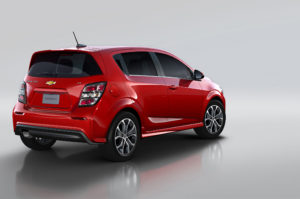
Sonic
So what did I buy? A Chevy Sonic, a small hatchback with a snappy look and 45 cubes of space with the rear seats down. Good mileage and exceptionally good safety ratings, it would be a great city car. I looked at electrics and hybrids but decided they don’t make much sense in the southwest. Distances are large between any two points so you have to consider driving range seriously. Just going to a movie and back is a 25-mile trip for me, and I live “in-town.” I wouldn’t get very far on electric power. Also, all our electricity out here comes from burning coal, so the environmental argument is not compelling. Add to that the large price premium on electrics and hybrids, the unknown cost of replacing the lithium batteries, the less-than-generous tax subsidies these days, and the numbers don’t add up. A small, economical gasoline engine makes most sense.
I bought the Sonic for $18K well-equipped with a “sport” package, alloy wheels, good sound system and lots of whizz-bang electronics. It’s a manual 5-speed because I enjoy feeling the engine as I drive. It was hard to find. Online, I located only two vehicles in the whole state with manual transmission and the trim level I wanted. Apparently, nobody drives a stick anymore. I learned that some dealers keep just one on the lot so they can advertise the lowest possible price for that model, but they don’t expect to sell it. Actually, my dealer first said he didn’t have one, but I had studied his inventory online and I knew he did so after some walking up and down the aisles in the acres of new vehicles in the back, we found it. I did drive an automatic but one spin around the block on the 5-speed and I was sold. I drove it home that afternoon.
After a few weeks driving, I’ve learned a lot about how new cars are being optimized for fuel economy. At my first gas fill-up I recorded 24 mpg, only 1 mpg below the sticker rating for city driving, not bad. After my second fill-up, I calculated 35 mpg, in the same town, over the same routes, nothing different. Why the huge jump in fuel economy? It was because I had learned how to drive the thing.
At first I had pushed each gear way up past 3500 rpm, the way the Scion had liked it. That was a high-revving car. But the sonic was not built that way. I was wasting fuel. By watching the calculation of instantaneous mpg in each gear, I could see that this car wanted to run at 2000, and in order to do that, I had to up-shift rather quickly. First gear was a very short run, hardly more than enough to overcome the inertia of rest, and second quickly got me to city speed then I needed to coast. I needed to spend hardly any time at all in the lower gears. My goal was to get to fifth as quickly as possible.
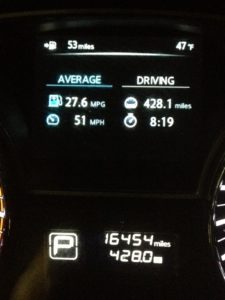 That’s the idea, anyway. In practice, it’s not a reasonable way to drive. In fifth gear I might be hitting 44 mpg according to the read-out, but I have no reserve acceleration. In city driving, you need to be ready to make moves. You can’t coast through town. So I run it in fourth, or even third because I see a hill up ahead or a city bus I’ll have to go around, and my mpg is sub-optimal because I’m driving in too low a gear.
That’s the idea, anyway. In practice, it’s not a reasonable way to drive. In fifth gear I might be hitting 44 mpg according to the read-out, but I have no reserve acceleration. In city driving, you need to be ready to make moves. You can’t coast through town. So I run it in fourth, or even third because I see a hill up ahead or a city bus I’ll have to go around, and my mpg is sub-optimal because I’m driving in too low a gear.
The automatics use a computer-controlled transmission which is always in the right gear to optimize mpg, and that means it also shifts up to fifth as quickly as possible. The problem is, when you press the accelerator, it has to either down-shift quickly or else lug fifth. My dissatisfaction driving the automatic was that it was sluggish. The automatic and its computer usually chose to lug the gear it was in unless you really stepped on it, then it would down-shift. The result was a sluggish, unresponsive ride. I had noticed the same in all the cars I drove, including the Honda Fit and the Mazda 3. It’s an acceptable performance, but there’s no joy in it.
Granted, a cheap mass-market city car is not supposed to be a sport vehicle, despite the name of the trim package, but why would I buy a car that was no fun to drive? That’s why I went to the manual transmission. But it turns out I’m not as smart as the computer that controls the automatic transmissions and so my mpg was below average. Except unlike that smarty-pants computer, I can learn, which I did.
So now I drive by running each gear quickly to near its inertial max, judged by engine noise and rpms, and keep moving up to the highest gear that lets me coast, but with a reserve acceleration. The secret is to always be anticipating what you’re going to need. I’ve started paying a lot more attention to geography, for example. If I see a high ridge ahead, I can gear down for the climb but when I reach the top, I put it immediately into fourth or even fifth, so I can coast down the other side. Likewise, I watch the traffic ahead, anticipating whether I can continue to roll forward in a relatively passive high gear, or whether I’m going to need a little oomph. By anticipating my acceleration needs, I can spend most of my trip essentially coasting passively. The Sonic is very well-balanced and coasts nicely. That’s how I added 11 mpg to my fuel economy, just by being conscious of my gears.
Am I as smart as a car computer? I ‘ve learned to optimize each gear like the computer would, but in addition, I can look ahead and evaluate what’s coming and prepare for it, something no computer can do at present. So my mpg results are actually better than the car’s sticker rating. Take that, automation!
I don’t drive fast or aggressively. I don’t race off the line at a green light or weave through traffic. I don’t even speed (much). A calmer style of driving definitely pays for itself. I do recall with nostalgia the days of youth when cars had big engines and you really did have to work that gearbox to make them go, and the engine feedback was rewarding. I don’t know why manufacturers don’t include sonic feedback to the cabin on low-end cars like the Sonic. It wouldn’t cost much and I could imagine I was driving a Ferrari. Maybe that’s the reason.
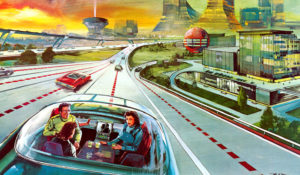 It won’t be long, possibly in my lifetime, before the whole idea of an individually piloted motor vehicle will seem absurd. The idea that millions of hairless monkeys are each qualified to safely guide several tons of glass and steel at high speed, separated from each other only by paint on the roadways, is ridiculous. Future generations will look back on this era and say, “Really?” But for now, the age of cars and petroleum is just beginning to come to a close and while it persists, this monkey wants to enjoy piloting his death-trap along the road.
It won’t be long, possibly in my lifetime, before the whole idea of an individually piloted motor vehicle will seem absurd. The idea that millions of hairless monkeys are each qualified to safely guide several tons of glass and steel at high speed, separated from each other only by paint on the roadways, is ridiculous. Future generations will look back on this era and say, “Really?” But for now, the age of cars and petroleum is just beginning to come to a close and while it persists, this monkey wants to enjoy piloting his death-trap along the road.
